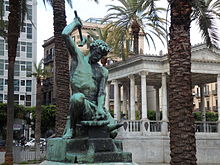Benedetto Civiletti
Benedetto Civiletti (born October 1, 1845 in Palermo , † July 22, 1899 ibid) was an Italian sculptor in Sicily .
Life
The sculptor Civiletti was one of the most important exponents of realism in Sicily in the 19th century.
Initially a student of a sculptor of nativity figures named S. Cozzi, he enjoyed further training with the painter Andrea D'Antonio and the sculptor Benedetto De Lisi from 1859 with the support of Giuseppe de Spucches , Principe di Galati . With a grant he finally came to Florence in 1863 in the workshop of the important sculptor Giovanni Dupré .
This was followed by exhibitions in Milan (1872), Vienna (1873), Palermo (1875) and Paris (1878). In particular his group of figures of the Canaris brothers, the heroes of the Greek liberation struggles, was celebrated by the public for their realistic and dramatic representation. The then Hereditary Prince Umberto I commissioned the sculptor to implement this sculpture in marble for the Villa Giulia in Palermo; it is now in the Giardino Inglese . The politically ambitious sculptures also include the work “The Last Hours of Missolunghi” shown in Turin in 1880 and the marble group “La battaglia di Dogali”, which was exhibited in Palermo in 1891. His sculpture "Christ in Gethsemane" earned him the cross of the French Legion of Honor in 1880 and membership in the Institut de France . In addition to large sculptures in marble and bronze, he created several portrait busts and grave monuments.
A monument was erected in Scicli in honor of Civiletti.
His brother Pasquale Civiletti (1858–1952), who trained under him, created the group of figures "I senza tetto" (The Homeless) (1895) for Piazza Castelnuovo in Palermo and the monument to Giuseppe Verdi , which was erected on October 12th ( Columbus Day ) was unveiled in 1906 in Verdi Square Park on New York's Upper West Side .
Works (selection)
- Giardino Inglese (Palermo): Marble group of the Canaris brothers (1879)
- Teatro Massimo (Palermo) : Allegorical bronze sculpture “La Tragedia” (tragedy). “La Lirica” (poetry) is by Mario Rutelli .
- Piazza Giulio Cesare (Palermo): bronze equestrian statue “ Vittorio Emanuele II ” from 1886
- Piazza Castelnuovo (Palermo): bronze monument “Il Lavoro” (The Worker) from 1894
- Palazzo Francavilla (Palermo): medallions of the Dukes Sperlinga (together with Mario Rutelli)
- Palazzo Ziino (Palermo): plaster models by Civiletti
- Teatro Politeama (Palermo) : bronze sculptures of the two riders left and right next to the quadriga of his pupil Mario Rutelli. The two riders on their horses represent the Olympic Games.
- Misilmeri : Fontana Grande (1879)
- Orto Botanico (Palermo) : bronze bust of Giuseppe Tineo (1894)
- Chiesa Santa Maria La Nova ( Scicli ): polychrome wooden statue “The Risen Christ” (attribution)
- Chiesa di San Pietro Modica : Sculpture group made of wood "Peter and the Lame"
- Galleria d'Arte Moderna (Palermo) : “Il Pifferaio” (The Cross Piper), around 1890 and “Putti” (1865)
- Galleria Nazionale d'Arte Moderna (Rome): Seated statue of Julius Caesar (1900)
literature
- Giulio Battelli : Civiletti, Benedetto . In: Ulrich Thieme (Hrsg.): General Lexicon of Fine Artists from Antiquity to the Present . Founded by Ulrich Thieme and Felix Becker . tape 7 : Cioffi – Cousyns . EA Seemann, Leipzig 1912, p. 22–23 ( Textarchiv - Internet Archive ).
- Carol Bradley: Civiletti, Benedetto. In: Alberto M. Ghisalberti (Ed.): Dizionario Biografico degli Italiani (DBI). Volume 26: Cironi-Collegno. Istituto della Enciclopedia Italiana, Rome 1982.
Web links
- Entry in the Archivio biografico comunale
- artnet.com
- flickr.com
- appuntiarte.splinder.com
Individual evidence
- ↑ Carol Bradley: Civiletti, Pasquale. In: Dizionario Biografico degli Italiani , Volume 26, 1982 (Italian).
- ↑ HISTORY OF POLITEAMA GARIBALDI (accessed March 2, 2016).
| personal data | |
|---|---|
| SURNAME | Civiletti, Benedetto |
| BRIEF DESCRIPTION | Italian sculptor of realism |
| DATE OF BIRTH | October 1, 1845 |
| PLACE OF BIRTH | Palermo |
| DATE OF DEATH | July 22, 1899 |
| Place of death | Palermo |



